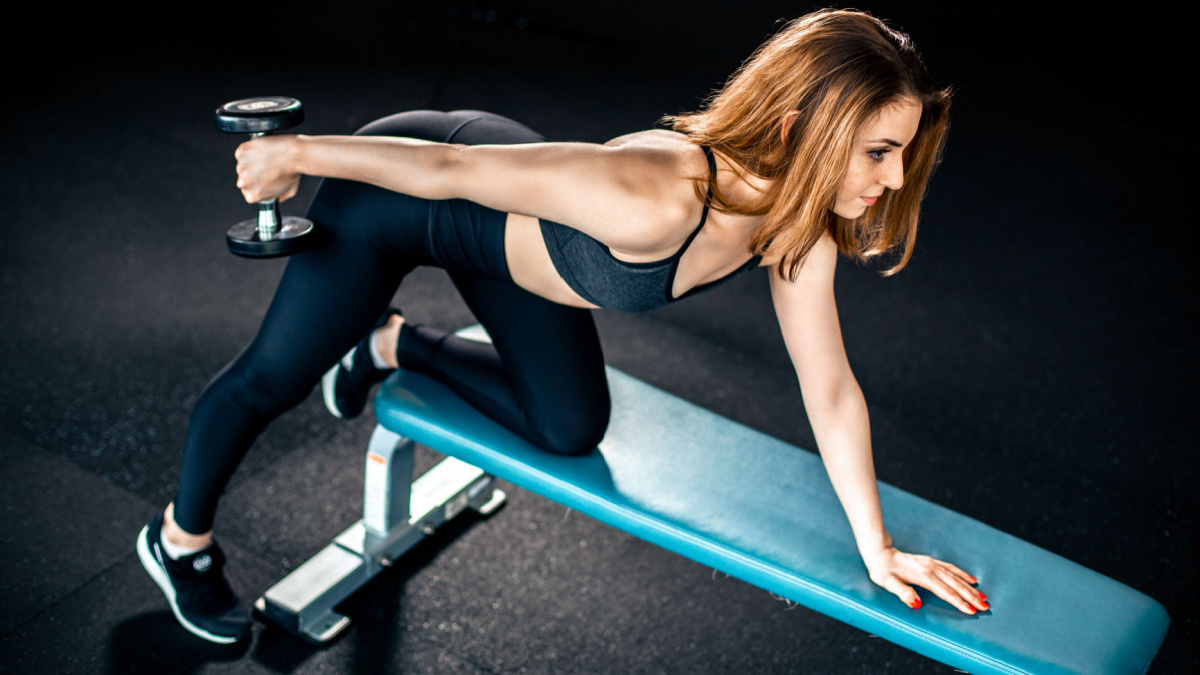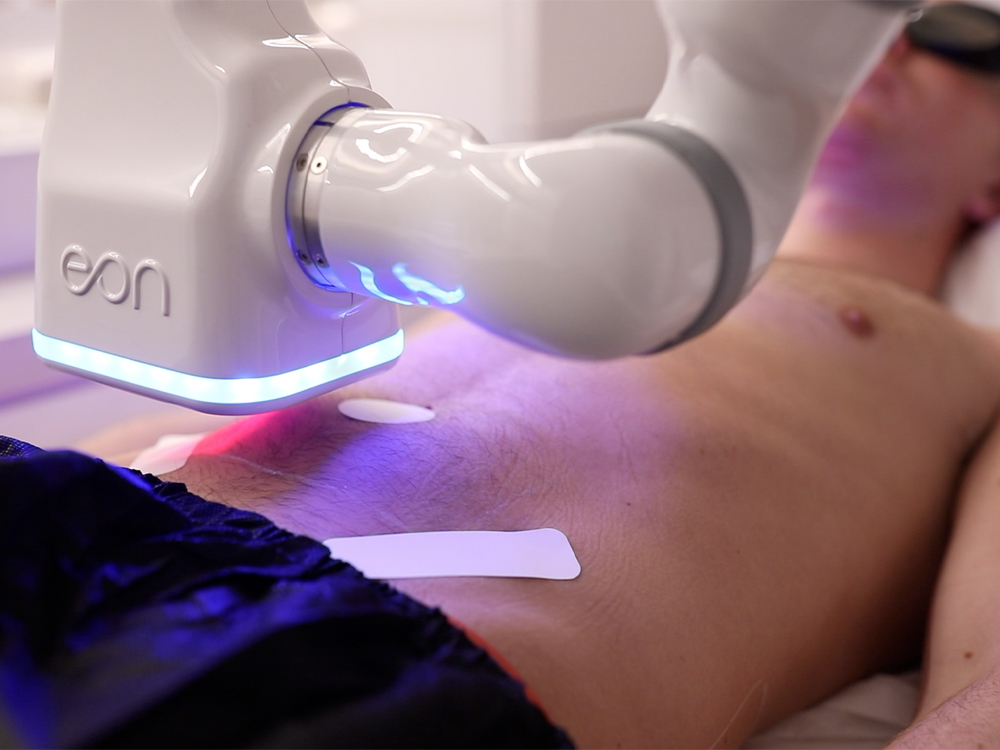
Mention the triceps kickback in certain lifting circles and you might generate some side eye looks of disappointment or even a bit of mocking laughter. This short-sighted response comes from the exercise’s unfortunate and unfair reputation of being ineffective, or being performed only by people with “less-than-serious” goals.
The dumbbell kickback was once a staple of bodybuilding’s Golden Era from the 1950s to the ’70s. However, its popularity in ’80s mainstream fitness classes diluted its muscle-building connection and it began to be performed with extremely light weights for extremely high repetitions. “To tone up without building bulk” was the popular, if misguided, logic.

Regardless of the misinformation, the triceps kickback is a very effective tool to target the biggest arm muscle — the triceps. The triceps are also a key muscle for performance through many upper body exercises. So forget what you might’ve heard about the exercise and learn the real reasons why you should include this exercise in your training regimen.
How to Do the Triceps Kickback
The basic single-arm dumbbell triceps kickback is an isolation (single-joint) exercise that focuses solely on triceps development. It’s a great way to emphasize peak contraction of the muscle.
Step 1 — Set Up in the Starting Position

Stand in front of something sturdy, like a rack or a bench. Hold one dumbbell and get into a wide stance. Bend your knees slightly and lean forward at the hips while keeping a neutral spine. Aim to have your torso almost parallel to the floor. Place your free hand on the rack or bench for maximum balance and stability.
Pull your working arm up so your elbow is near your ribs and pinned close to your body. Let your forearm hang perpendicular to the floor with your palm facing in toward your body. Don’t look up or forward. Keep your head in line with your spine and your chin slightly tucked in.
Form tip: Flaring your elbow away from your body will only encourage cheating to move more weight and potentially strain your elbow joint. Keep your upper arm glued to your side. This is not an exercise to move super-heavy weight. Keep the load relatively light to ensure impeccable form.
Step 2 — Reach a Peak Contraction

Brace your core and exhale while flexing your triceps until your arm is completely straight. Squeeze at the top for a second to feel a maximum peak contraction. Your lower arm should be the only thing moving. This is an isolation exercise, so focus on only working the triceps.
Your hand, and the dumbbell, should pivot around your elbow. Treat your elbow like a hinge. No other part of your body should move.
Form tip: Be sure to reach full extension with each rep. In the top position, your entire arm should be nearly parallel to the ground. Because gravity offers minimal resistance against the weight in the bottom part of the movement, it’s essential to use a full range of motion and emphasize the contraction.
Step 3 — Return to the Stretched Position

Slowly come back to the starting position while inhaling. Again, only your forearm should move. Pause very briefly in the bottom position to avoid quickly swinging the weight down and up.
Sure, momentum might allow you to move more weight, but you will diminish the range of motion and the time under tension — both crucial for muscle mass. Swinging the weight will also put more stress on the elbow joint. More joint strain with less muscle-building is not a great bargain.
Form tip: Start each set with your weaker or non-dominant side so you have more energy and more focus. Perform all repetitions and then match the same number of repetitions with your stronger arm, even if one side is capable of more reps. This will help to balance common strength or development discrepancies between left and right arms.
Triceps Kickback Mistakes to Avoid
This exercise can be prone to bad execution because it requires light weights, so a lifter can sometimes lose focus. Learn about the most common errors and how to avoid them.
Swinging the Weight
Let’s be real for a second: cheating a few reps at the end of a session won’t smite you instantly. It can sometimes even be beneficial, for experienced lifters using it as a deliberate intensity-boosting technique. But for the vast majority of people, you should avoid cheating and swinging the weight with kickbacks or nearly any exercise.

If you swing and cheat, you will only actually work your triceps through a very short portion of the range of motion, and the exercise will provide a limited triceps-building stimulus. Moreover, this will result in more stress to the elbow joint and you don’t want to develop tendonitis — that’s the best way to keep having small arms.
Avoid it: Make sure you control the eccentric (lowering the weight), and even pause for a dead-stop at the bottom briefly. If you focus on only moving your forearm, you basically cannot cheat. If your elbow moves, you’ve started doing a dumbbell row, not a triceps kickback.
Not Locking Out Your Arm
If you don’t completely extend your arms and squeeze your triceps in a hard lockout, you lose most of the benefits of this exercise because of the resistance curve. At the start of the lift, there is almost no resistance at all because the dumbbell isn’t directly moving against gravity. The hardest part of the exercise is in the shortened range when the muscle is contracted.

If you don’t lockout, which can happen if you try using too much weight, then you don’t really work your triceps’ most challenging part of the range of motion. That ends up making the exercise easier and less efficient for muscle growth.
Avoid it: Make sure you use a proper weight that allows you to fully lockout your arm. If you can’t pause at the top for a second, the weight is too much.
Benefits of the Triceps Kickback
Even though the exercise is often overlooked and disrespected, the triceps kickback has unique benefits for your triceps training and will help you get bigger, stronger arms.
Muscle Growth
This exercise is focused on directly training the triceps, specifically for hypertrophy (muscle growth). Indeed, this exercise thrives with lighter weight and a longer time under tension, which is a great way to build muscle and create an aesthetic physique. (1)

Moreover, as an isolation exercise, it is the perfect fit for developing a mind-muscle connection and accumulating triceps-specific volume without taxing other muscle groups, which are both beneficial for muscle growth. (2)(3)
Pressing Strength
Triceps strength, and the pushing pattern in general, are involved in many sports like volleyball, American football, combat sports, etc. And let’s not forget strength sports like powerlifting.
Sure, the triceps kickback won’t create pure neurological strength like training the heavy bench press or overhead press, but building larger triceps muscles can eventually improve strength. (4) So if you’re interested in performance, fit this into your accessory training.
Training the Shortened Range
Many triceps exercises such as skull crushers emphasize the lengthened range of motion and stress the stretched position. The triceps kickback, on the other hand, focuses on the shortened or contracted portion. Because of its resistance curve, the exercise is relatively easy in the stretched position and much more challenging in the peak contraction.
This can provide a novel stimulus, help develop a stronger mind-muscle connection, and unlock new gains, because training variety can be better for motivation and hypertrophy in itself. (5)
Easy on the Elbows
The triceps kickback can be invaluable for experienced lifters with cranky joints. Because the upper arm is in a higher position than the forearm, and joint isn’t being strained through the entire range of motion, the elbow can move more freely without significant stress.
If you have nagging pain in your elbows, shoulders, or wrists, or if you’re prone to tendonitis, make the kickback appear regularly in your training plan.
Muscles Worked by the Triceps Kickback
The aim of the exercise is to train your triceps, but some postural muscle will be recruited as well to hold the position.
Triceps Brachii
This is the biggest arm muscle and the main target of the kickback. It is made of three heads. Two of them (the medial and the lateral head) go from the elbow to the humerus (upper arm bone). These are responsible for extending the arm.

The long head also extends the arm, but because it is attached to the scapula, it also extends the shoulder and raises the arm. Because the upper arm is positioned alongside the torso, the triceps kickback emphasizes the lateral and medial heads.
Back
The whole back — upper back, lats, and lower back — work to maintain a parallel body position and stabilize the working arm during the kickback. The back’s involvement should be limited to the muscles working statically to hold your body’s position without movement.
However, if the kickback is performed improperly, the back muscles (specifically the upper back and lats) may become more significantly recruited, drawing muscular stress away from the triceps.
Who Should Do the Triceps Kickback
The goal of the kickback is to add meat onto your triceps. So if you’re looking for bigger, stronger arms — like plenty of people in the gym — you can include this lift in your training regimen.
Beginners
Some people advise that beginners to avoid single-joint exercises and focus primarily on the big basics (multi-joint compound lifts like presses). This is generally sound advice, but isolation work can also have benefits for newer lifters.
By improving the mind-muscle connection with specific muscles, they can feel that muscle work more effectively, which leads to better growth and body awareness. Exercises like the triceps kickback also help to directly train muscles which may be under-worked when compound exercises are overemphasized.
Physique Enthusiasts
Whether your goal is to look better or to compete in a physique show, the triceps kickback is a perfect fit. Performing this exercise allows you to increase triceps volume without fatiguing other muscle groups, leading to focused muscle growth.
This is very valuable, for instance, if you lack overall arm development, or if you need to create a balanced and symmetrical physique by correcting muscular imbalances.
Strength Athletes
If you’re an athlete that requires pressing strength such as a powerlifter, strongman/strongwoman, or CrossFit athlete, then triceps training is essential. Including the triceps kickback can be surprisingly effective for strength athletes.
The relatively light weight and high muscular tension allows them to increase triceps training volume without aggravating their elbows, which are usually already beaten up by heavy lifting.
How to Program the Triceps Kickback
The kickback is a single-joint exercise and as such, it is not ideal for moving heavy weights because additional muscles will be excessively recruited. The kickback is most effective using moderate to light weight to stimulate muscle growth and zero-in on working the triceps.
Moderate Weight, Moderate Repetitions
The time-tested bodybuilding scheme of three to four sets of 10 to 12 repetitions will be your kickback bread and butter. This is a very efficient way of increasing volume leading to muscle growth.
Light Weight, High Reps
This exercise can really shine with higher reps because of its resistance curve, cumulative time under tension, and its low impact on the joints. Performing two to four sets of 15 to 20 repetitions can serve as an amazing finisher to really scorch your triceps. It can also be a great way to start your arm workout by really warming-up your elbow joints.
Triceps Kickback Variations
The single-arm dumbbell kickback is a great exercise in itself, but you can tweak it to better suit your goals or provide a different feeling. Here are the main kickback variations.
Cable Triceps Kickback
Instead of using dumbbells, use a cable. Instead of attaching a handle, grab the cable by the “ball” at the end, just above the cable clip. This allows you to keep a neutral hand position without straining your wrists.
The exercise may not seem like much because of the relatively lighter weight, but the cable provides constant tension through the lift, even more than using a dumbbell. This stimulates the triceps throughout the entire range of motion, which will increase the time under tension and lead to improved muscle growth.
Pronated Kickback
This subtle variation was popularized by bodybuilding coach John Meadows. Using a pronated (palms-down) grip will emphasize the medial head of the triceps. Using two dumbbells at once also changes the total-body stability requirement.
Because your forearm is slightly rotated, this variation will also address forearm and wrist health. You can even perform a type of superset, beginning with reps of pronated kickbacks and then immediately transitioning to standard neutral-grip kickbacks.
Two-Arm Dumbbell Kickback
This variation is pretty straight-forward: Perform the standard triceps kickback with both arms at the same time. This will slightly decrease the weight you can lift because the muscle focus is “divided” between both arms.
This variation also requires more work from your core, back, and legs to stabilize yourself because you don’t have a free hand to brace on an outside support.
Triceps Kickback Alternatives
If you’re still not convinced to incorporate kickbacks, here are some alternatives that will share similar benefits to spice up your training. Variety will challenge the muscles differently, promoting new muscle growth.
Triceps Pushdown
If you’ve got access to a cable station, you can perform this fundamental exercise. The triceps pushdown, sometimes called a pressdown, emphasizes the peak contraction and isn’t very stressful on the elbow joints.
Use an attachment that allows you to extend your arms completely — a rope handle is often most effective. As with the kickback, be sure to keep your arms close to your body and only move your hands and forearms without swinging your elbows.
Decline Dumbbell Skull Crusher
The standard flat bench skull crusher is an effective exercise, but using a decline bench gives it a twist to focus more on the medial and lateral heads of the triceps. The arm angle doesn’t provide as much stretch or long head stimulation, but can offer more tension in the top position.
Using a pair of dumbbells allows your arms to move freely and reduce strain on your wrist and elbow joints, compared to performing the exercise the a barbell or EZ-curl bar.
Overhead Dumbbell Extension
If you want to emphasize the long head of the triceps, this variation is for you. Performing triceps extension with your arms extended above your shoulders will focus more on the lengthened range and will significantly recruit the long head because it’s involved in raising the arm.
Because this movement emphasizes the stretched position, be sure your elbows and shoulders are thoroughly warmed up. It’s not an ideal first-exercise in your triceps workout, but it can be a key player in building larger arms.
FAQs
Do I have to train my arms directly?
It depends on a few variable. If you’re a short-limbed lifter, your arms will probably be significantly stimulated with compound exercises like the bench press, overhead press, rows, and pulldowns. But if you’re dealing with long arms, you should train them directly because your leverage on big lifts is different and the biceps and triceps are often under-stimulated in those movements.
Ultimately, if you’re interested in having bigger arms, it’s a good idea to include at least some direct training, especially if you’re a more advanced lifter. If you’re a competitive athlete, you should skip direct arm training in-season and keep that energy for your sport-specific training. Accumulating too much training volume can cause burnouts, stagnation, or even regression.
I can’t stop my elbow from flaring. Why is that?
The first culprit could be weight. If the dumbbell is too heavy, flaring your elbow out will recruit extra muscles (in your back and shoulders) to help lift the load, but it’s at the potential detriment of your joints and it will reduce triceps activation.
If you’re certain that you can control the weight, it could be a matter of mobility. If your upper back or shoulder mobility is compromised, it will result in protruded, forward-pointing shoulders that prevent you from keeping your elbows close to you. You should include a mobility routine in your workouts with exercises like band pull-aparts and wall slides.
Let’s Get Pumping
The triceps kickback’s bad reputation is unfair and unfounded. Don’t let any misinformed knee-jerk reactions or cliches steer you away from this classic arm-builder. It’s a versatile movement that lets you hit your tris with light weight, high tension, and minimal joint strain. It’s definitely time to remind today’s gyms that kickbacks are for serious lifters.
References
- Burd NA, Andrews RJ, West DW, Little JP, Cochran AJ, Hector AJ, Cashaback JG, Gibala MJ, Potvin JR, Baker SK, Phillips SM. Muscle time under tension during resistance exercise stimulates differential muscle protein sub-fractional synthetic responses in men. J Physiol. 2012 Jan 15;590(2):351-62. doi: 10.1113/jphysiol.2011.221200. Epub 2011 Nov 21. PMID: 22106173; PMCID: PMC3285070.
- Calatayud J, Vinstrup J, Jakobsen MD, Sundstrup E, Brandt M, Jay K, Colado JC, Andersen LL. Importance of mind-muscle connection during progressive resistance training. Eur J Appl Physiol. 2016 Mar;116(3):527-33. doi: 10.1007/s00421-015-3305-7. Epub 2015 Dec 23. PMID: 26700744.
- Schoenfeld BJ, Contreras B, Krieger J, Grgic J, Delcastillo K, Belliard R, Alto A. Resistance Training Volume Enhances Muscle Hypertrophy but Not Strength in Trained Men. Med Sci Sports Exerc. 2019 Jan;51(1):94-103. doi: 10.1249/MSS.0000000000001764. PMID: 30153194; PMCID: PMC6303131.
- Reggiani C, Schiaffino S. Muscle hypertrophy and muscle strength: dependent or independent variables? A provocative review. Eur J Transl Myol. 2020 Sep 9;30(3):9311. doi: 10.4081/ejtm.2020.9311. PMID: 33117512; PMCID: PMC7582410.
- Baz-Valle E, Schoenfeld BJ, Torres-Unda J, Santos-Concejero J, Balsalobre-Fernández C. The effects of exercise variation in muscle thickness, maximal strength and motivation in resistance trained men. PLoS One. 2019 Dec 27;14(12):e0226989. doi: 10.1371/journal.pone.0226989. PMID: 31881066; PMCID: PMC6934277.
Featured Image: IvanRiver / Shutterstock






